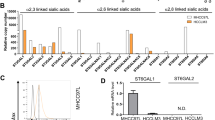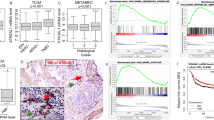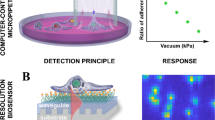Abstract
Aim:
We aimed to investigate the potential modification of previously unrecognized surface glycoprotein(s) by α2,6-sialylation other than by integrins.
Methods:
The expression of β-galactoside α2,6-sialyltransferase (ST6Gal-I) in the colon cancer cell line HCT116 was reduced by siRNA. The adhesion and Boyden chamber assay were used to detect the variation in cell motility. α2,6-Sialylation proteins were detected with lectin affinity assay. The mRNA expression, protein expression and downstream signaling modulation with siRNA were detected using reverse transcription-polymerase chain reaction, flow cytometry analysis, and Western blot.
Results:
In HCT116 cells, the knockdown of ST6Gal-I inhibited cell motility, but did not affect cell adhesion. This selectively altered cell migration was caused by the loss of α2,6-sialic acid structures on c-Met. Moreover, STAT3 was dephosphorylated at tyrosine 705 in ST6Gal-I-knockdown (ST6Gal-I-KD) HCT116 cells.
Conclusion:
c-Met is the substrate of ST6Gal-I. The hyposialylation of c-Met can abolish cell motility in ST6Gal-I-KD HCT116 cells.
Similar content being viewed by others
Log in or create a free account to read this content
Gain free access to this article, as well as selected content from this journal and more on nature.com
or
References
Collard JG, Schijven JF, Bikker A, La Riviere G, Bolscher JG, Roos E . Cell surface sialic acid and the invasive and metastatic potential of T-cell hybridomas. Cancer Res 1986; 46: 3521–7.
Morgenthaler J, Kemmner W, Brossmer R . Sialic acid dependent cell adhesion to collagen IV correlates with in vivo tumorigenicity of the human colon carcinoma sublines HCT116, HCT116a and HCT116b. Biochem Biophys Res Commun 1990; 171: 860–6.
Wang PH, Li YF, Juang CM, Lee YR, Chao HT, Tsai YC, et al. Altered mRNA expression of sialyltransferase in squamous cell carcinomas of the cervix. Gynecol Oncol 2001; 83: 121–7.
Seales EC, Jurado GA, Singhal A, Bellis SL . Ras oncogene directs expression of a differentially sialylated, functionally altered beta1 integrin. Oncogene 2003; 22: 7137–45.
Seales EC, Jurado GA, Brunson BA, Wakefield JK, Frost AR, Bellis SL . Hypersialylation of beta1 integrins, observed in colon adenocarcinoma, may contribute to cancer progression by up-regulating cell motility. Cancer Res 2005; 65: 4645–52.
Lin S, Kemmner W, Grigull S, Schlag PM . Cell surface alpha 2,6 sialylation affects adhesion of breast carcinoma cells. Exp Cell Res 2002; 276: 101–10.
Pochec E, Litynska A, Amoresano A, Casbarra A . Glycosylation profile of integrin alpha 3 beta 1 changes with melanoma progression. Biochim Biophys Acta 2003; 1643: 113–23.
Semel AC, Seales EC, Singhal A, Eklund EA, Colley KJ, Bellis SL . Hyposialylation of integrins stimulates the activity of myeloid fibronectin receptors. J Biol Chem 2002; 277: 32830–6.
Symington BE, Symington FW, Rohrschneider LR . Phorbol ester induces increased expression, altered glycosylation, and reduced adhesion of K562 erythroleukemia cell fibronectin receptors. J Biol Chem 1989; 264: 13258–66.
Chiricolo M, Malagolini N, Bonfiglioli S, Dall'Olio F . Phenotypic changes induced by expression of beta-galactoside alpha2,6 sialyltransferase I in the human colon cancer cell line SW948. Glycobiology 2006; 16: 146–54.
Lise M, Belluco C, Perera SP, Patel R, Thomas P, Ganguly A . Clinical correlations of alpha2,6-sialyltransferase expression in colorectal cancer patients. Hybridoma 2000; 19: 281–6.
Takayama H, LaRochelle WJ, Sharp R, Otsuka T, Kriebel P, Anver M, et al. Diverse tumorigenesis associated with aberrant development in mice overexpressing hepatocyte growth factor/scatter factor. Proc Natl Acad Sci USA 1997; 94: 701–6.
Blume-Jensen P, Hunter T . Oncogenic kinase signalling. Nature 2001; 411: 355–65.
Cramer A, Kleiner S, Westermann M, Meissner A, Lange A, Friedrich K . Activation of the c-Met receptor complex in fibroblasts drives invasive cell behavior by signaling through transcription factor STAT3. J Cell Biochem 2005; 95: 805–16.
Zhang YW, Wang LM, Jove R, Vande Woude GF . Requirement of Stat3 signaling for HGF/SF-Met mediated tumorigenesis. Oncogene 2002; 21: 217–26.
Darnell JE Jr, Kerr IM, Stark GR . Jak-STAT pathways and transcriptional activation in response to IFNs and other extracellular signaling proteins. Science 1994; 264: 1415–21.
Patten I, Placzek M . Opponent activities of Shh and BMP signaling during floor plate induction in vivo. Curr Biol 2002; 12: 47–52.
Acknowledgements
This work was supported by the National Basic Research Program Grant (No 2003CB716400) of China, the Natural Science Foundation of China for Distinguished Young Scholars (No 30725046) and the Natural Science Foundation of China for Innovation Research Group (No 30721005).
Author information
Authors and Affiliations
Corresponding authors
Rights and permissions
About this article
Cite this article
Qian, J., Zhu, Ch., Tang, S. et al. α2,6-hyposialylation of c-Met abolishes cell motility of ST6Gal-I-knockdown HCT116 cells. Acta Pharmacol Sin 30, 1039–1045 (2009). https://doi.org/10.1038/aps.2009.84
Received:
Accepted:
Published:
Issue date:
DOI: https://doi.org/10.1038/aps.2009.84
Keywords
This article is cited by
-
The HOTAIR/miR-214/ST6GAL1 crosstalk modulates colorectal cancer procession through mediating sialylated c-Met via JAK2/STAT3 cascade
Journal of Experimental & Clinical Cancer Research (2019)
-
Sox2 promotes expression of the ST6Gal-I glycosyltransferase in ovarian cancer cells
Journal of Ovarian Research (2019)
-
Discovery of a new series of imidazo[1,2-a]pyridine compounds as selective c-Met inhibitors
Acta Pharmacologica Sinica (2016)
-
Computational identification of novel natural inhibitors of glucagon receptor for checking type II diabetes mellitus
BMC Bioinformatics (2014)
-
Role of UDP-N-Acetylglucosamine2-Epimerase/N-Acetylmannosamine Kinase (GNE) in β1-Integrin-Mediated Cell Adhesion
Molecular Neurobiology (2014)



